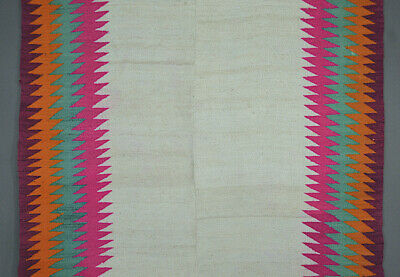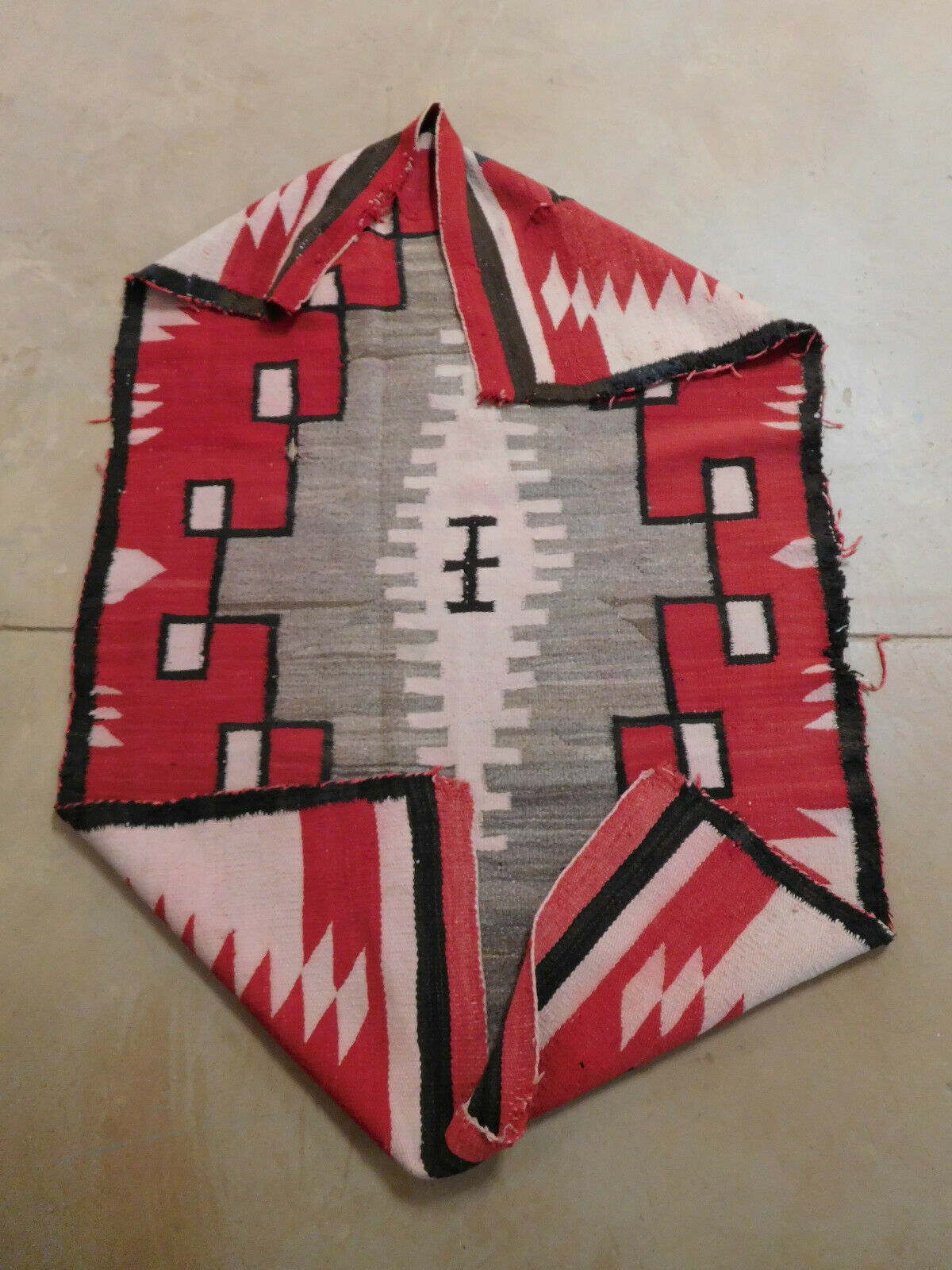-40%
BEAUTIFUL WHITE Rio Grande-Like QUECHUA INDIAN BLANKET Field-Collected TM13179
$ 261.36
- Description
- Size Guide
Description
Experts in Finding Rare Ancestral Art for Your Collecting InterestsAN ATTRACTIVE VINTAGE QUECHUA INDIAN BLANKET
FROM HIGHLAND BOLIVIA
Inventory Number:
TM13179
Type of Art:
Blanket for bedding
Native Name:
Kama phullu
Linguistic Group:
Altiplano Kichwa (Quechua)
Origin:
Field-collected in Aguas de Castilla Village, elevation about 12,020 feet, Cantón Cocani, south of Salar de Uyuni, Nor Lipez Province, Department of Potosí, Bolivia.
Age:
Vintage, circa 1970s.
Approximate Size:
81 by 56 inches
Use:
A relatively heavy blanket used primarily for bedding.
Condition:
Excellent, lightly used. No stains, no irregularities of any kind. Clean, displayable and usable condition.
Remarks:
This vintage blanket with zigzag lateral designs (reminiscent of old Saltillo sarapes) denotes antique iconography from the region. Woven in two vertical pieces with a hidden center seam, all of the yarn is handspun, single-ply sheep wool. Relatively heavy and large. The all-natural off-white field is nice. Perfect for wall display or cover for a bed.
We encourage you to ask for additional information or photos. Our studies and collecting of South American indigenous arts began in 1977. Upon request, the successful buyer shall receive a 111-page resume of our experience in this field.
https://www.paypal.com/biz/fund?id=TNNCE6Z74PQ9G
----------------------------------------------------------
ANDESAMAZON SHIPPING
DURING THE VIRUS PANDEMIC
International Bolivian postal service is suspended during the C-19 pandemic.
All items are shipped with DHL with estimated arrival time to the U.S.A. in 12 to 14 days
. We will ship worldwide but the cost to other countries may increase slightly and we do not know how long shipping may take. Most items are posted within one to five working days of payment because Bolivian citizens may leave home only twice a week on prescribed days.
ALL OUR ITEMS ARE SHIPPED FREE OF CHARGE TO THE AMERICAS
AND INCLUDE TRACKING NUMBERS FOR YOUR CONVENIENCE
WE PROMISE TO DO EVERYTHING POSSIBLE TO ASSURE THAT YOU ARE SATISFIED WITH YOUR PURCHASES.
ANDES AMAZON "DATING" TERMS:
PREHISTORIC, PRE-COLUMBIAN, ANCIENT = Before around A.D. 1500.
18TH CENTURY = A.D. 1700 to 1799.
19th CENTURY = 1800 to 1899.
TURN-OF-THE-19TH-CENTURY = 1890 to 1910.
EARLY-20TH CENTURY = 1900 to 1933.
MID-20TH CENTURY = 1934 to 1966.
LATE-20TH CENTURY = 1967 to 1999.
TURN-OF-THE-20TH-CENTURY = 1995 to 2005.
EARLY-21ST CENTURY = 2000 to Present.
COLONIAL = A.D. 1532 to 1825.
ANTIQUE = Over 50 years old.
VINTAGE = Over 30 years old.
CONTEMPORARY = Made in the last 5 years.
CIRCA = "Approximately/around/within a few years of."
ANDES AMAZON TEXTILE “CONDITION” TERMS:
Terms used to describe the physical condition of textiles is often subjective and varies greatly from one observer to another. What certain dealers identify as “mint” condition, we call “good”; what some call “excellent” condition, we call “fair.” Following are explanations of the terms we use.
MINT = Like new. Unused -- as if recently removed from the loom. No wear or patina of any kind. These textiles may have “nubs” or even loose, uncut threads left over from the weaving process.
EXCELLENT = Usually only lightly used, often well-guarded or stored for many years. Some textiles might exhibit insignificant, light wear, staining or soiling from use. Older textiles commonly show, patina and sheen from age. The colors may have muted ever so slightly due to age or exposure, often improving the beauty of a textile. From a displayable distance, textiles appear perfect.
VERY GOOD = Usually lightly or only periodically used. The textiles often lightly but evenly worn with no tears or distracting holes. Older textiles may exhibit lightly darkened surfaces from use and age (staining and soiling) or with lightly noticeable discoloration. At a displayable distance, textiles appear in outstanding condition.
GOOD = Usually moderately to well-used. Light to medium staining, either isolated or throughout, represents a common characteristic of this condition. Parts of the textile may feature tiny holes from wear, occasionally exposing hidden warp or weft yarns. Lightly frayed edges often manifest in these textiles. Surface discoloration due to age and exposure often improves the appearance of a textile in “GOOD” condition. Light or isolated, dye “run” occasionally appears. Textiles display well, despite minor damage.
FAIR = Either well-used or moderately abused. “Bleeding” or dye “run” as well as extensive wear characterize these textiles. Missing sections of fringe, tassels or edges often result from overuse. Many 20th-century weavings exhibit noticeably faded colors. Textiles in otherwise excellent condition may contain a single isolated sector of damage, such as a large hole, that greatly reduces its aesthetic appeal. Most vintage tribal textiles for sale in the Western Hemisphere constitute those in “FAIR” to “GOOD” condition.
POOR = Textiles exhibiting extreme usage and damage. These pieces do not display well and serve primarily as study specimens or examples of very rare textiles.
OUR COMMITMENT
We believe the world deserves improving. We believe in a higher, aspiring destination for humanity. We know that conflicts decline through mutual respect. We know that understanding our differences leads to mutual wellbeing. We trust that our Mother Earth and our Universe provide unlimited resources for every man, woman and child to live in peace, happiness and love. As stewards of the human race, our intrinsic responsibility rests on improving our world as much as possible.
“Native” groups, also known as tribal folk, original residents, indigenous people, aboriginals, First Nations, traditional ethnicities, autochthonous societies, autochthonal cultures, et. al. dominated human existence until recently. At some point, of course, we all shared common ancestors… regardless of current culture, creed or color. Regrettably, however, in the past 500 years or so, thousands of unique tribal groups disappeared due to misunderstanding and impudence. Uncontrolled aspects of colonialism, ethnocentrism, racism and politicization led to the direct and circuitous destruction of myriad native groups, each representing a valuable resource for our planet. Over 6000 of the nearly 7000 languages currently spoken face danger of extinction. The vast majority of those constitute ethnic indigenous tongues. We believe in cherishing and carefully supporting the very few “Native” groups that remain on earth, even while standing on the brink of losing them. Disconnecting with indigenous spirit, wisdom and traditional knowledge represents a loss for all of us.
Our window into vanished customs emerges through literature, paintings, photographs, a few audio or visual recordings and material culture, or the objects our ancestors created.
In many cases, physical creations represent our only resources for understanding past human beliefs and aspirations. For more than a quarter century, the professional interests of those behind ANDESAMAZON remain dedicated to documenting “traditional” South American indigenous cultures, especially through their material culture. Our field studies lead us to some of the most remote people on the continent. Through the years, we witnessed certain Native Americans existing nearly exactly as their ancestors did in prehistoric times… and others jumping from 18th century existence to 21st century reality in the blink of an eye. The benefits of our ethnographic investigations manifest as valuable data related to linguistics, cultural history, ethno-environmental relationships, socio-cultural organization, cosmology, mythology, spirituality and of course, material culture.
Our holistic approach to understanding the past through material arts contributes authentic information related to the people who created those pieces. Not only can beautiful and interesting objects enhance ones´ personal environment, but they also provide invaluable knowledge regarding different ideologies, unique ways of life and past or nearly extinct traditions. We encourage every buyer to intimately study each piece and learn as much as possible about its origin, function, importance and spiritual history. ANDESAMAZON suggests sharing with companions, friends and especially children, whatever understanding, knowledge and insights you obtain from our objects. In this small way, we feel inspired in preserving something of native cultures and making the world a better place. Thank you for working with us.
THANK YOU FOR YOUR INTEREST AND SUPPORT
Copyright © 2006-2008, 2010, 2011 Pete Fritz All Rights Reserved


















